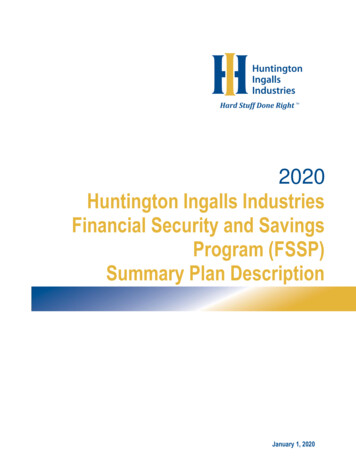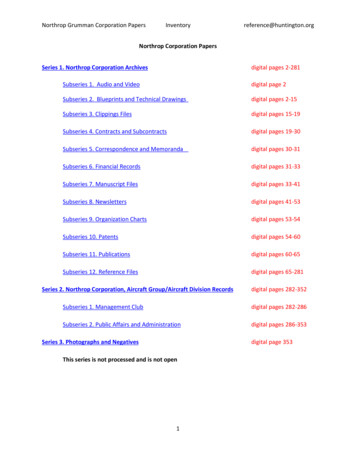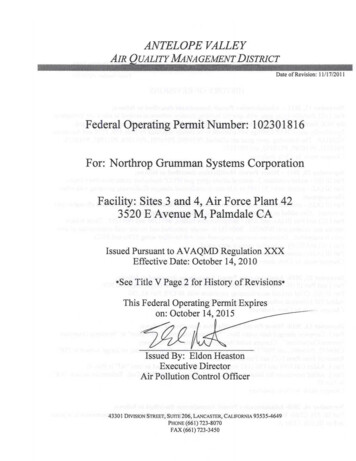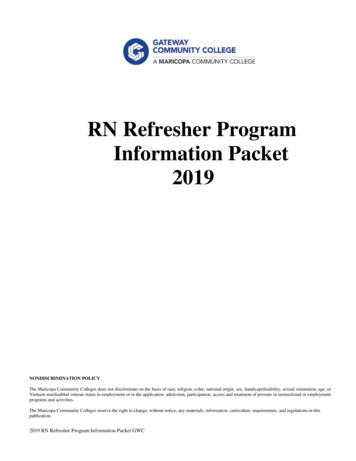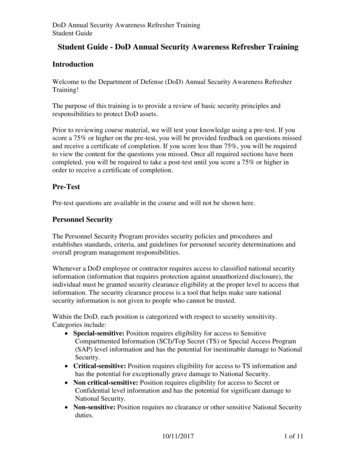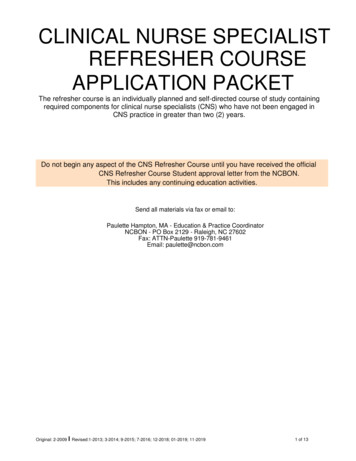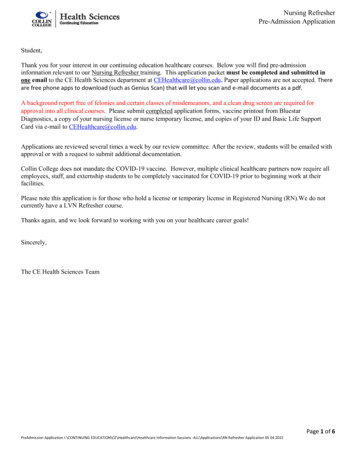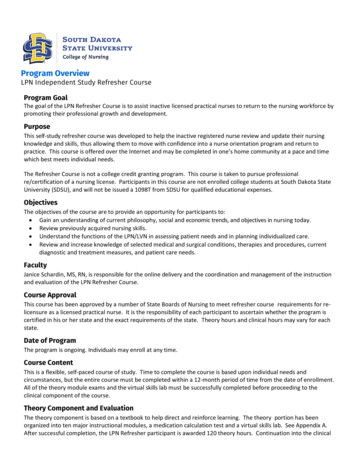
Transcription
DoD/SPECIALS1/6/2021SASC-SS DOD SPC-NGVersion 2ANNUAL SECURITY REFRESHER TRAININGThis annual refresher training is provided to you as a reminder or your obligations andresponsibilities as a cleared individual.INTRODUCTIONUpon completion of this module you should be able to: Reaffirm your obligations that you agreed to when you received your security clearanceor access. Describe types of government information, implement safeguards, and report dataspillage. Be alert to and appropriately report potential threats by adversaries, insiders, and otherharms. Carry out your responsibilities when escorting visitors. Understand your personal reporting responsibilities and obligations under the UnitedStates espionage and sabotage acts.MEETING OUR SECURITY COMMITMENTSNorthrop Grumman is accredited to perform classified work. You have been granted a securityclearance or access based on the company’s requirements and customer’s determination.Customers perform comprehensive security reviews to assess our performance of securityobligations. Violations of our obligations could place the company and cleared individuals at riskof losing the eligibility to perform this type of work.YOUR OBLIGATION – LEGAL AND BINDINGWhen receiving your clearance or access you confirmed by signing a non-disclosure agreementthat you understand the consequences of violating your cleared obligations and agreed to: Accept a life-long obligation to protect classified information. Submit for pre-publication review any writing intended for public distribution. Avoid unauthorized disclosure, retention, or negligent handling of sensitive governmentinformation and materials.While there are a number of statutes mentioned in this agreement, violations of the statutes ofTitle 18 or Title 50 of the United States code can lead to prison sentences, fines, or both.Page 1 of 21
DoD/SPECIALS1/6/2021SASC-SS DOD SPC-NGVersion 2PROHIBITED ITEMSIn the event that you are accessing a classified facility –Department of Defense restricted area orSpecial Access Program Facility, there are requirements prior to entering. No Bluetooth orwireless devices are allowed in any restricted area. Please lock up all Bluetooth and/or wirelessdevices outside of the restricted area prior to entering. Failure to do so can result in a possiblecompromise of classified information, resulting in a security infraction or violation. Prohibiteddevices can include but are not limited to the list below: Computers (desktop or laptop)Cellphones, tablets, blackberry’s, TelevisionsCameras, video playersSmart WatchesMP3 PlayersThumb DrivesRemotely controlled medical devices*MP3 CDsTwo-way devices (radios, walkie-talkies, pagers)Tape RecordersHeadphone with Wireless, Bluetooth, Noise Cancelling/Microphone capabilities*Note: Some medical devices such as hearing aids and insulin pumps may have Bluetoothcapabilities. Please contact your local program security representative prior to enteringany SAPF so a waiver can be coordinated with the specific customer.If you are unsure if a device is authorized, contact your local security office prior to entering arestricted area. In the event that you or another individual brings a prohibited item into a restrictedarea, remove the prohibited item from the area immediately, secure it, and then contact your localsecurity office at your earliest convenience for reporting requirements.TYPES OF GOVERNMENT INFORMATIONThere are two categories of government information that you might handle in your work –unclassified and classified.Unclassified government material is material that does not require a security clearance. However,it can still be very sensitive information and require special handling. Examples of this type of dataare For Official Use Only (FOUO) and Controlled Unclassified Information (CUI). These types ofinformation are not for public disclosure.Unclassified material that is co-mingled with classified material must be marked.The statement of work provided with your tasking or the overall contract document will providespecific instructions on the handling of these types of materials. For further guidance, consult yourPage 2 of 21
DoD/SPECIALS1/6/2021SASC-SS DOD SPC-NGVersion 2program manager, supervisor, or contracting officer.CLASSIFIED GOVERNMENT INFORMATIONClassified government material requires the person handling or given knowledge of theinformation have the required clearance or access for that information and a need-to-know.When classified material is generated, it carries one of the following designations: “Originally classified” is material classified by a government official or so designated inwriting by the President of the United States. “Derivatively classified material” is any material subsequently derived by a sourcedocument(s) or from guidance provided by a security classification guide or DD254 (agovernment directive form). As a cleared contractor employee creating classifiedmaterials, you are a derivative classifier.You are responsible for reviewing the security classification guides and directives associated withyour program. Classification guides are available from your security office. If you are unsure howto interpret the classification guide, consult your supervisor or manager. It is your responsibility todetermine appropriate classification and proper marking.PROTECTING CLASSIFIED MATERIALSAlways maintain direct control of classified information. Provide access to classified material onlyto those with appropriate clearance and with a need-to-know.Review your holdings annually, retain for only as long as needed, and properly disposition themwhen no longer needed.Possessing a security clearance is not adequate justification for accessing classified information.Understand that classified information reported in the press or available on the Internet is stillclassified. Never confirm, deny, or comment on classified information.END OF DAY SECURITY CHECKSConduct an end-of-the-day security check for yourself and your work area to ensure that: Systems are shut down, locked and password protected. Material is properly stored. Containers and areas are secured.Page 3 of 21
DoD/SPECIALS1/6/2021SASC-SS DOD SPC-NGVersion 2ESCORTING REQUIREMENTSAll employees who possess a DoD clearance or have special access to a restricted area arerequired to know their escorting requirements. In the event that you need to bring an unclearedvisitor (one that does not possess a DoD clearance or is not SAP/SCI briefed) into a restrictedspace, please follow your escorting requirements. If you are unsure of an individual’s clearancelevel or need-to-know, please contact your local security for verification prior to allowing entry toa restricted area. Do not bring a visitor into a restricted space without following the escorting stepsoutlined for your specific restricted area, which may include the following common steps: Prior to entering the restricted space, notify everyone along your planned route that youare about to bring in an uncleared person. This will allow adequate time for the area to besanitized of classified information and classified systems can be locked appropriately.Ensure the uncleared individual locks up all prohibited Bluetooth and/or wireless devicesprior to entering, with the exception of any emergency personnelBring the uncleared visitor into the space and announce “UNCLEARED IN THE AREA”.Turn on the overhead warning light, if applicable.Sign the visitor log appropriatelyEscort the visitor along the pre-planned route with a hand-held flashing light, if available,and constantly announce “UNCLEARED WALKING THROUGH”Ensure areas are sanitized before allowing uncleared to pass to prevent inadvertentdisclosures.When the work is complete, exit down the same path as you entered, continually notifyingemployees in your vicinity that the uncleared visitor is walking throughAs you exit the area, sign the visitor out of the log and turn off any warning lightIf you need additional escorting training, please contact your local security office.Escorting requires you to be within line-of-sight of the uncleared individual at all times. In the eventthat you need to leave the restricted area prior to the work being complete, please pass offescorting duties to another cleared employee or have the uncleared individual exit the area withyou.Failure to follow your escorting requirements could result in a possible compromise to classifiedinformation, resulting in a security infraction or violation. If you have any issues during escortingor believe there was a possible compromise of classified information, please contact your localsecurity immediately.HOSTING CLASSIFIED MEETINGSAt the start of a classified meeting, set and announce the level of the meeting. Prior to beginningany classified discussion or disseminating any classified information, the meeting host isresponsible to ensure:Page 4 of 21
DoD/SPECIALS1/6/2021SASC-SS DOD SPC-NGVersion 2 The location is secure and discussions cannot be overheard. Attendees have the appropriate clearance and access levels. Attendees have need-to-know. Electronic devices are removed or powered off, depending upon procedures.Remember, never process classified information on an unclassified computer system. Themeeting host can coordinate with Security if a classified computer is required.We are all responsible for security —take actions immediately if you notice that someone has anelectronic device or if you can hear conversations from another meeting room, indicating that yourmeeting conversations may also be overheard.CODE BLUE – AWARENESS AND REPORTINGThe company maintains the required high level of protection for classified information providedby or developed for U.S. government agencies. We must all be aware of the potential for classifiedinformation being inappropriately introduced into an unauthorized information system(s). Theseare data spills. Northrop Grumman refers to a data spill as “Code Blue.”Immediately report a suspected Code Blue to your Security point of contact. If you are not able toreach a Security point of contact, report the potential Code Blue directly to the Cyber SecurityOperations Center (CSOC) at 877-615-3535. When reporting a Code Blue, do not disclosepossible classified information over unsecure channels.Follow these instructions to prevent further proliferation: Do not delete or forward any information. Do not attempt any cleanup of the information on your own. Disconnect the computer, and do not use the affected system until you are told that it issafe to do so.References: CTM J100 Company Security Manual Code Blue websiteINSIDER THREAT“Insider threat” is the term used for the potential harm posed when an individual intentionally orunwittingly uses or exceeds access to negatively affect information or systems, or compromisesour government customer’s mission.Insiders committing illegal acts and unauthorized disclosure can negatively affect national securityand industry in many ways. These acts can result in: Loss of technological advantagePage 5 of 21
DoD/SPECIALS1/6/2021SASC-SS DOD SPC-NGVersion 2 Compromise of classified, export-controlled, or proprietary informationEconomic loss; andEven physical harm or loss of life.These types of threats from trusted insiders are not new, the increasing numbers of those withaccess to data and the ease with which information can be transmitted or stored can make illegalaccess and compromise easier. A recent DSS brochure on insider threats cited that in the 11most recent cases, 90% used computers while conducting espionage and two-thirds initiated thecontact via the Internet.LOOK FOR AND REPORT INDICATORS OF POSSIBLE INSIDER THREATWe must all be on the alert for behaviors that might be indicators of an insider threat. Knowingthe safeguards that must be applied to handling company and customer information, reportbehaviors such as: Mishandling or misusing company or customer informationRemoving company or customer information from premises for unauthorized, personal, orunknown reasonsCopying company or classified information unnecessarilyEngaging in classified conversations without a need-to-knowEstablishing unauthorized means of access to company or customer information systemsSeeking access to company proprietary, controlled sensitive, or classified information onsubjects not related to job dutiesOther behaviors that might indicate a possible insider threat include: Unreported foreign contacts or overseas travelSudden reversal of financial situation or repayment of large debts or loansIf you observe any of these behaviors or suspicious behaviors by an individual, report the activityto your management, Security, or the MySecurity website.While not all suspicious behaviors or circumstances represent a threat, each situation must beexamined along with information from other sources to determine whether or not there is a risk.Observing even a single activity and not reporting it can increase the potential damage that canbe done.Case Example: Go with your GutAna Belen Montes was recruited by Cuba after learning of her views against the U.S. policiestowards Central America. At that time she was a clerical worker in the Dept. of Justice. Shewent to work for the Defense Intelligence Agency and became the DIA’s top Cuban analyst.While security officials became aware of her disagreement with U.S. foreign policy and hadPage 6 of 21
DoD/SPECIALS1/6/2021SASC-SS DOD SPC-NGVersion 2concerns about her access to sensitive information, she had passed a polygraph test.According to a FBI news story, in 1996 “an astute DIA colleague acting on a gut feeling reported to a security official that he felt Montes might be under the influence of Cubanintelligence.” She was interviewed, but admitted nothing.Four years later when the FBI was working to uncover an unidentified Cuban agent, the securityofficial recalled the interview and contacted the FBI. An investigation was opened that led toher arrest and conviction.References: CTM J100 Company Security Manual Find Security contact information on your sector home webpage or on the SecurityServices page. Find other resources in the Counterintelligence & Insider Threat section on theEnterprise Security webpageTHREAT LANDSCAPEThe U.S. cleared industry is a prime target of many foreign intelligence collectors and governmenteconomic competitors attempting to gain military and economic advantages. Click here to viewthe DCSA Counterintelligence annual report, "Targeting U.S. Technologies: A Report of ForeignTargeting of Cleared Industry."Cyberspace enables social engineering attacks with readily available information aboutbusinesses and people.For example, spear phishing attacks use social engineering to trick an individual into providinginformation or clicking on a link or attachment containing malicious software that can provideunauthorized network access, ex-filtrate information, or do other harm.Report spear phishing and suspicious activity, for example anomalous computer behavior to theCSOC at CSOC@ngc.com or 1- 877-615-3535.ADVERSARY METHOD: ELICITATIONElicitation is the strategic use of conversation to subtly extract information about you, your work,or your colleagues. Foreign intelligence officers are trained in elicitation tactics.The Internet and social networking sites make it easier to obtain information to create plausiblecover stories. Unsuspectingly, a conversation or relationship that starts out purely social graduallyprovides information or part of a puzzle that the foreign operative can combine with otherinformation.Page 7 of 21
DoD/SPECIALS1/6/2021SASC-SS DOD SPC-NGVersion 2Employees should always be aware of the possibility of elicitation attempts both at work and incasual settings. Be prepared by knowing what information you cannot share and be suspicious ofthose who seek that information. If you believe someone is attempting to elicit information, youcan say you don’t know, refer them to the Internet, try and change the topic, or provide a vagueanswer.Because elicitation is subtle and can be difficult to recognize, report any suspiciousconversations to Security or the MySecurity website.Attending a trade show or conference? Understand the limits of information you can provide.Report contacts if you experience insistent questions outside of the scope of what you havealready provided, or attempts at unnecessary ongoing contact.Are you a subject matter expert? Report unsolicited requests for assistance; requests to reviewthesis papers, drafts publications, or research-related documents; or unsolicited invitations toattend international conferences.Don’t reply to unsolicited requests for information. Suspicious email can be reported to the CyberSecurity Operations Center at CSOC@ngc.com. Report suspicious phone contacts to theMySecurity website.Safeguards When Participating in External ConferencesIf you are participating at a conference or meeting as a speaker, discussion panelist, ormoderator where you are identified as a Northrop Grumman employee, follow Corporate PolicyCPA6 Employee and External Communications, or your sector’s Communication procedure forclearance of public speeches. Don’t connect your laptop to conference-provided networks or connect to the companynetwork using their computer kiosks. Beware of potential eavesdropping when having work-related conversations in-personor over the phone. Report unusual contact attempts or occurrences to Security.Reference: Where to Report webpage Security Points of Contact webpageADVERSARY METHOD: RECRUITMENTRecruitment is obtaining cooperation from someone to provide information.Anyone with information or access to information could be a potential target. Safeguard youractions and words to avoid becoming an easy target.Page 8 of 21
DoD/SPECIALS1/6/2021SASC-SS DOD SPC-NGVersion 2You may not realize at first that you have been spotted for possible recruitment. In initialcontacts the adversary will try to determine if you have information or access of value, orif you might have such information in the future.If the adversary is interested, he or she will attempt to develop the relationship and devise a ruseto establish a logical basis for continuing contact. The adversary will continue to assess yourwillingness to provide information.The adversary’s goal is to establish a relationship of friendship and trust. It could start withrequests such as professional advice or information about a co-worker. You might have a senseof obligation and not see any harm in complying. The adversary could then move the relationshipalong and step-up the information requests, for example, as a consultant.Use caution if you feel you are being recruited. Listen carefully Be observant Remember as many details as possible Keep all options open by neither agreeing or refusing to cooperate Stay calm Be non-committal Ask for more timeInform your Security Representative immediately if you have any suspicious conversations orsuspect you are being recruited.You are not being asked to avoid all foreign contacts. Your main defense against espionage isbeing aware of the signs of recruitment and elicitation, knowing not to respond to even seeminglycasual questions for more information about the work that you do, and reporting all suspiciouscontacts to your Security office. Contacts can come in various forms, either in-person or online.Case Example: As Much Time as it TakesIn 2010, ten deep-cover Russian spies were arrested. The individuals in the group married,bought homes, and had children as they appeared to assimilate into American life while activelycollecting information and spotting and assessing potential recruits.Reference: Where to Report webpage Security Points of Contact webpagePage 9 of 21
DoD/SPECIALS1/6/2021SASC-SS DOD SPC-NGVersion 2REPORTINGCompliance with security requirements is an on-going part of your position. The purpose ofreporting possible threats and compromises is to detect and mitigate any vulnerability to ourcountry and its resources, which includes Northrop Grumman and our employees.Immediate threats and security compromises should be reported directly to your local Securityteam. The MySecurity website can be used to report suspicious activity, including insider threat,and suspicious contacts. These reports will be sent to your site specific designee.Northrop Grumman employees are encouraged to report within company channels prior tocontacting the government defense hotline. However, if you are not satisfied with the results ofyour contact at the company level, you are encouraged to report to the DoD hotline. Commentsand questions made during these contacts must be kept unclassified. Phone: 800-424-9098 Government e-mail: hotline@dodig.osd.mil Web: http://www.dodig.mil/hotlineIf your report deals with a special access program please use that approved reporting methodversus the process described here.References: CSOC (Cyber Security Operations Center): CSOC@ngc.com or 1-877-615-3535monitored 24x7 Ethics and Business Conduct website for links to Business Conduct Officers andOpenLine(OPERATIONS SECURITY) OPSEC PROCESSCompilation of unclassified information could lead to an adversary’s ability to collect, process,analyze, and misuse that information.Operations security (OPSEC) is a process to identify critical information and protect it fromadversaries by controlling and protecting generally unclassified information. The process has fivecomponents: Identifying the Critical Information Analyzing the Threat Analyzing the Vulnerabilities Assessing the Risk Initiating the CountermeasuresPage 10 of 21
DoD/SPECIALS1/6/2021SASC-SS DOD SPC-NGVersion 2Consider OPSEC daily by identifying information that should be not posted to public websites orthrown out in the trash or recycle bins. Share only on a need-to-know basis and disposeappropriately.For example, while our company contact information is not sensitive information, we would markcontact information for employees at an entire site as Northrop Grumman Proprietary Level I sothat the information is not inadvertently released outside of the company.Could this be valuable information to an adversary?If yes, then don’t post it on social media: Nobody’s going to be at work tomorrow – the network’s going to be out! I just saw the budget figures for Project X – you won’t believe it! They still can’t get this right – still not passing QA.BADGINGPhysical security measures are applied to company facilities for the safety of individuals andprotection of company information. All individuals having access to a facility must be badged. Inmost cases, our badges (if assigned a OneBadge) provide information about the wearer,including: Identifying employees or non-employeesCountry of citizenshipClearance access, andFor short term visitors, whether or not escort is requiredWear your company badge in plain view above your waist at all times on company premises,unless you are using your OneBadge for computer access. When using your OneBadge forcomputer access, remain physically present and in control of your badge.In addition to access to facilities, our badges may also allow access to computer resources andother privileges. Protect your badge from loss, theft, damage, misuse, and counterfeiting. Yourbadge should only to be used for company purposes. When entering any Northrop Grummanfacility or secure area, do not tailgate! Everyone must present their own badge or PIN to the cardreader to confirm valid access. Ensure the door closes behind you. See local security if yourequire access and your badge is not programmed. Remove your badge when not on companypremises. Don’t store your badge with your laptop. Report lost or stolen badges immediately toyour management and Security so that certifications and privileges written to the chip andmagnetic strip can be suspended to prevent misuse pending resolution.In a facility or area with badge-controlled access, if you encounter an unbadged individual or anunaccompanied individual with a badge marked “Escort Required,” you should escort theindividual to the nearest manned Security access control point.Page 11 of 21
DoD/SPECIALS1/6/2021SASC-SS DOD SPC-NGVersion 2Reference: CTMJ100 – Company Security ManualBe Sure: Don’t leave your badge on display in your car. Don’t use your badge for identification not related to company business. Don’t allow your badge to be photographed, scanned, or otherwise reproduced.SHORT TERM VISITORS AND FOREIGN PERSON VISITORSIf you are escorting a badged visitor, understand your escort responsibilities as detailed in CTMJ100 Company Security Manual and Corporate Form C-878 Acknowledgement of EscortResponsibilities, including: Keep the visitor within sight and in your control at all times. Only provide the visitor access to approved areas essential to the purpose of the visit. Coordinate with Security before taking the visitor into classified, closed, or restricted areas. Prevent the unauthorized exposure to company proprietary information. If disclosure isauthorized, inform the visitor of the proprietary nature of the material. Ensure the visitor understands and does not violate restrictions on the use of personaldevices or prohibitions of photography and recording on company premises. Ensure the visitor does not connect non-company devices to company networks ordevices unless specific, prior Information Security approval has been obtained. Follow site Security requirements for the return of the visitor badge.NON-U.S. CITIZEN VISITSVisits of non-U.S. citizens or Foreign Persons to company U.S. facilities must be coordinated inadvance with Security and Export Control to ensure compliance with requirements andresponsibilities associated with ITAR/EAR (International Traffic in Arms Regulation/ExportAdministration Regulations). Remember that Northrop Grumman employees representing entitieslocated outside the U.S. may have the same requirements as other foreign visitors. The NorthropGrumman sponsor must process a Foreign Visitor Request through the Enterprise ExportManagement System (EEMS). See CTM J100 Company Security Manual for all requirements,process, and definitions of non-U.S. citizen and Foreign Person. Some facilities may have morestringent, contractual security requirements.If you are a host or an escort to a Foreign Person visitor, you have specific responsibilities detailedin CTMJ100.References: CTM J100 Company Security ManualPage 12 of 21
DoD/SPECIALS1/6/2021SASC-SS DOD SPC-NGVersion 2 Corporate Form C-878 Acknowledgement of Escort ResponsibilitiesYOUR REPORTING REQUIREMENTSAs a cleared individual, you have a legal obligation to report certain events, not only about yourselfbut also your coworkers. Reportable events include: Loss, compromise or suspected compromise of classified information. Known or suspected security violations involving classified data. Changes in personal status —such as: name change, marriage, divorce, cohabitation,citizenship, or when an employee no longer has a requirement for a security clearance oraccess. See your local program security team for specific guidance for this category. Becoming a representative of a foreign interest— including work or material support foran adversary government, company, or individual.You are also required to report information of an adverse nature. Adverse information includes: Arrest or detention by any law enforcement agency. Tickets and fines greater than 300. Unfavorable financial situations such as bankruptcy, garnishment of wages, and excessiveindebtedness. Unexplained affluence, anything from outside your personal financial (401K, home equity)or income channels, such as a sudden wealthy lifestyle without an increase in salary likefamily monetary gifts, inheritance, or winnings. Uncontrolled use of substances (alcohol, prescription drugs, or illegal narcotics). Treatment and counseling for mental or emotional disorders— excluding grief, family ormarital counseling and treatment related to adjusting from military service, unlessmedication has been prescribed. Other matters that could have an adverse impact on your ability to safeguard classified orproprietary material.Report events and adverse information to your Security Representative. This information will beheld in the strictest confidence following company and U.S. government policy. If you are not sureif information is reportable, check with your Security Representative.Page 13 of 21
DoD/SPECIALS1/6/2021SASC-SS DOD SPC-NGVersion 2DODThis portion of the security refresher module covers DoD specific information.CLASSIFICATION LEVELSThere are three distinct levels of classification within the Department of Defense (DoD) system: ConfidentialoConfidential is information, that when compromised could cause damage to ournational security. SecretoSecret is information, that when compromised could result in grave damage to ournational security. Top SecretoTop Secret is information, that when compromised could result in exceptionallygrave damage to our national security.To access any of these three types of information you must have a clearance at that level orhigher and a valid need-to-know.DERIVATIVE CLASSIFIERAs a cleared contractor employee, if you create classified materials as a part of your jobresponsibilities either by incorporating, paraphrasing, restating or compiling information that isalready classified. You are considered a derivative classifier.To comply with government regulations, a derivative classifier must take training every two yearsto continue to create classified material or to have access to a classified computer system. If youare a derivative classifier, this training will be assigned to you.Page 14 of 21
DoD/SPECIALS1/6/2021SASC-SS DOD SPC-NGVersion 2SPECIALSAs a part of maintaining your additional
DoD/SPECIALS 1/6/2021 SASC-SS_DOD_SPC-NG Version 2 Page 1 of 21 ANNUAL SECURITY REFRESHER TRAINING This annual refresher training is provided to you as a reminder or your obligations and responsibilities as a cleared individual. INTRODUCTION . Upon completion of this module you should be able to:
